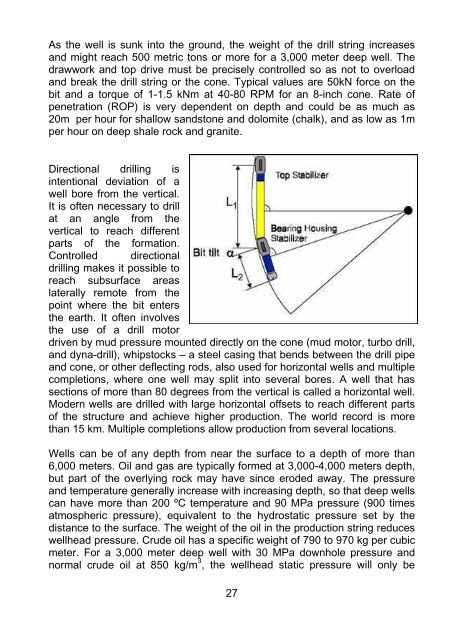Oil and gas production handbook An introduction to oil ... - ABB Group
Oil and gas production handbook An introduction to oil ... - ABB Group
Oil and gas production handbook An introduction to oil ... - ABB Group
You also want an ePaper? Increase the reach of your titles
YUMPU automatically turns print PDFs into web optimized ePapers that Google loves.
As the well is sunk in<strong>to</strong> the ground, the weight of the drill string increases<br />
<strong>and</strong> might reach 500 metric <strong>to</strong>ns or more for a 3,000 meter deep well. The<br />
drawwork <strong>and</strong> <strong>to</strong>p drive must be precisely controlled so as not <strong>to</strong> overload<br />
<strong>and</strong> break the drill string or the cone. Typical values are 50kN force on the<br />
bit <strong>and</strong> a <strong>to</strong>rque of 1-1.5 kNm at 40-80 RPM for an 8-inch cone. Rate of<br />
penetration (ROP) is very dependent on depth <strong>and</strong> could be as much as<br />
20m per hour for shallow s<strong>and</strong>s<strong>to</strong>ne <strong>and</strong> dolomite (chalk), <strong>and</strong> as low as 1m<br />
per hour on deep shale rock <strong>and</strong> granite.<br />
Directional drilling is<br />
intentional deviation of a<br />
well bore from the vertical.<br />
It is often necessary <strong>to</strong> drill<br />
at an angle from the<br />
vertical <strong>to</strong> reach different<br />
parts of the formation.<br />
Controlled directional<br />
drilling makes it possible <strong>to</strong><br />
reach subsurface areas<br />
laterally remote from the<br />
point where the bit enters<br />
the earth. It often involves<br />
the use of a drill mo<strong>to</strong>r<br />
driven by mud pressure mounted directly on the cone (mud mo<strong>to</strong>r, turbo drill,<br />
<strong>and</strong> dyna-drill), whips<strong>to</strong>cks – a steel casing that bends between the drill pipe<br />
<strong>and</strong> cone, or other deflecting rods, also used for horizontal wells <strong>and</strong> multiple<br />
completions, where one well may split in<strong>to</strong> several bores. A well that has<br />
sections of more than 80 degrees from the vertical is called a horizontal well.<br />
Modern wells are drilled with large horizontal offsets <strong>to</strong> reach different parts<br />
of the structure <strong>and</strong> achieve higher <strong>production</strong>. The world record is more<br />
than 15 km. Multiple completions allow <strong>production</strong> from several locations.<br />
Wells can be of any depth from near the surface <strong>to</strong> a depth of more than<br />
6,000 meters. <strong>Oil</strong> <strong>and</strong> <strong>gas</strong> are typically formed at 3,000-4,000 meters depth,<br />
but part of the overlying rock may have since eroded away. The pressure<br />
<strong>and</strong> temperature generally increase with increasing depth, so that deep wells<br />
can have more than 200 ºC temperature <strong>and</strong> 90 MPa pressure (900 times<br />
atmospheric pressure), equivalent <strong>to</strong> the hydrostatic pressure set by the<br />
distance <strong>to</strong> the surface. The weight of the <strong>oil</strong> in the <strong>production</strong> string reduces<br />
wellhead pressure. Crude <strong>oil</strong> has a specific weight of 790 <strong>to</strong> 970 kg per cubic<br />
meter. For a 3,000 meter deep well with 30 MPa downhole pressure <strong>and</strong><br />
normal crude <strong>oil</strong> at 850 kg/m 3 , the wellhead static pressure will only be<br />
27

















